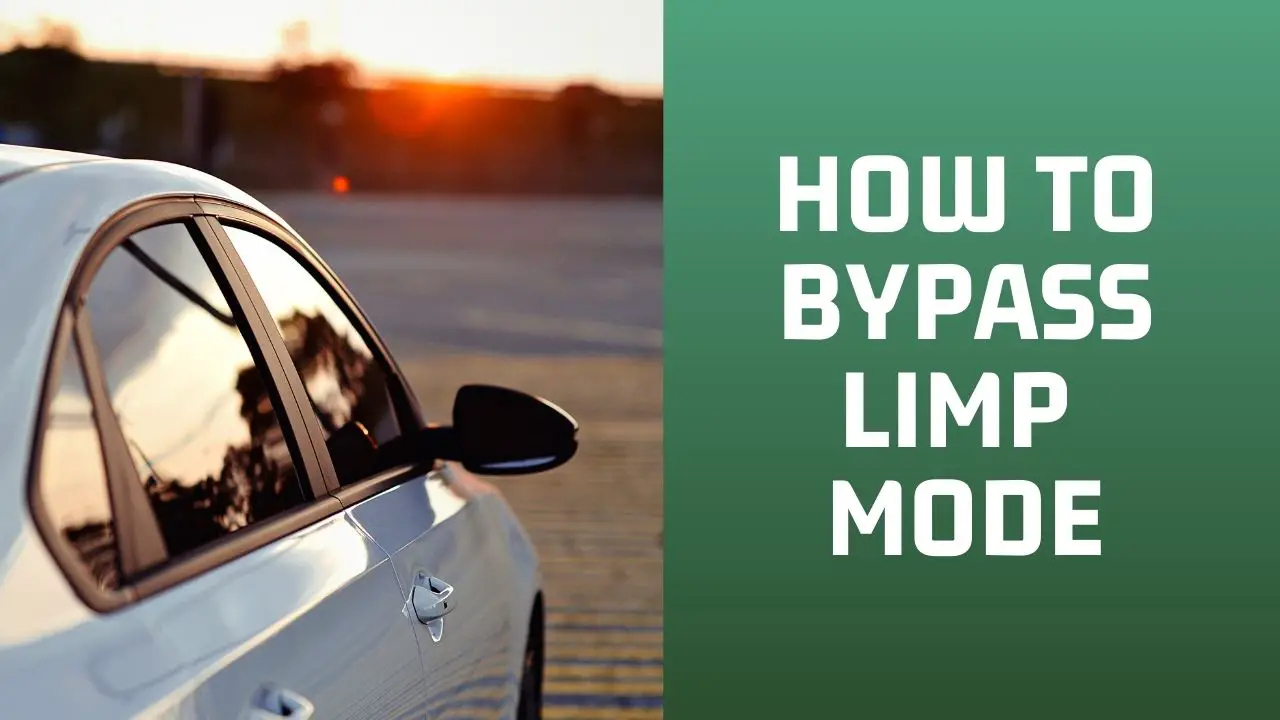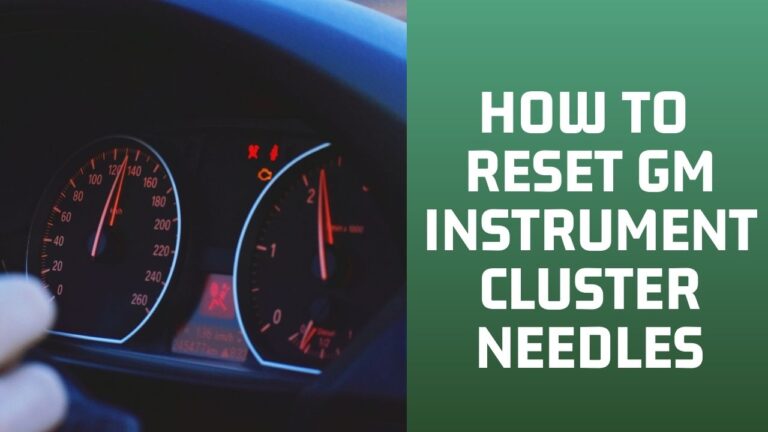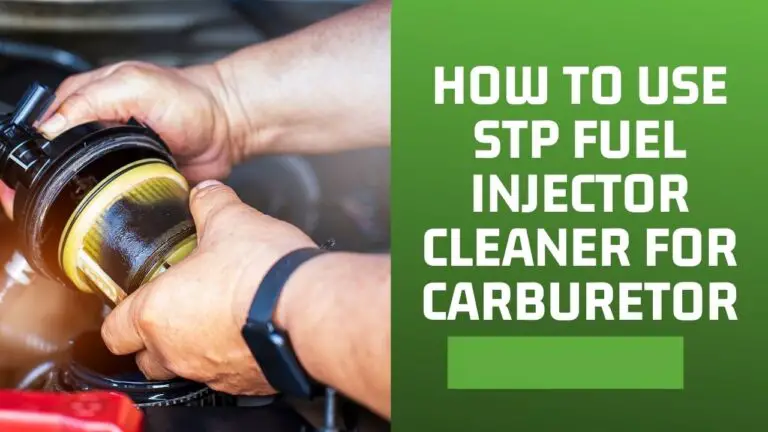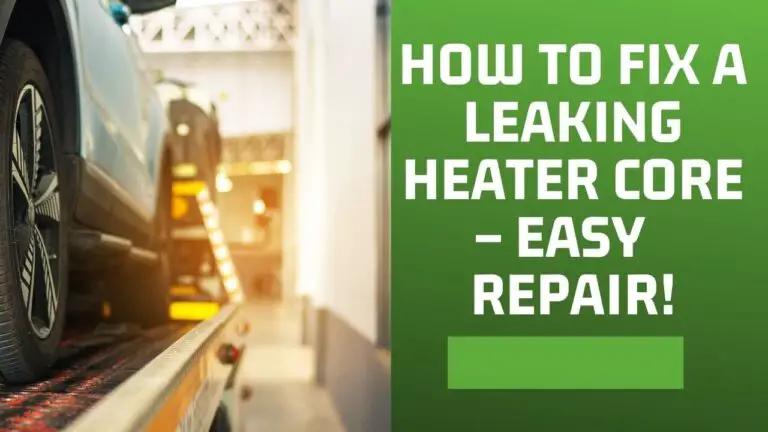Limp mode is an extremely frustrating problem when you are on the side of the road waiting for help and your car isn’t moving.
Fortunately, there are several things you can do to bypass limp mode and make it easier to get help quickly, so you can get back on the road again as soon as possible.
What Is Limp Mode?
Limp mode refers to the vehicle’s inability to provide full power to the wheels because of an issue with the engine or transmission that can be corrected in most cases.
One of the most annoying things about driving a car is when it decides not to work properly.
When your vehicle reaches limp mode, it stops working for some time, and the restarts by itself.
This issue occurs because of an issue with your car’s onboard diagnostics system.
If you want to learn how to bypass limp mode, read on! We have all of the information that you need right here.
What Causes Limp Mode?
There are many different causes of limp mode, but they are usually related to one thing: lack of fuel.
When your engine runs out of gas or doesn’t receive enough fuel, it will shut down and go into limp mode until there is enough fuel to run again.
Sometimes, though, vehicles can experience issues that make them think they don’t have enough fuel even if they do.
Causes of Limbs
If you haven’t tried to fix your car yourself before, you probably don’t know what limp mode is.
It’s a term that dealerships use when a vehicle isn’t operating at its best.
When it comes up, you might be a little lost as to what repairs your vehicle needs.
Since there are many potential causes of limp mode, you have to be able to identify why your car is having problems before you can proceed with repairs.
Because limp mode is caused by a lack of combustion, there are several reasons why it can develop.
Most often, limp mode occurs because of a faulty spark plug or sensor.
However, problems with injectors, fuel pump, or even a clogged, fuel filter can also cause limping or stalling.
If you’re experiencing these issues, have your vehicle checked as soon as possible.
The longer you wait, the more likely it is that your engine will need major repairs.
ALSO SEE: 3057 vs. 3157 Bulbs
Limp Mode Symptoms
Dropping RPM’s, Vibrating Motors, Fluctuating LCD Screen, and Strange Noises are all symptoms of a car going into limp mode.
When your vehicle is in limp mode it will typically only drive at 15-25 mph depending on which mode your vehicle is on.
To get out of limping mode you have to have a professional diagnose what is wrong with your vehicle and fix it, or bypass limp mode yourself.
Is Limp Mode Dangerous?
In most cases, no, it’s not dangerous.
However, if you have an older vehicle or one that needs repairs and are worried about driving, it’s best to contact a mechanic or drive slowly until you can figure out what is wrong with your car.
Also, remember that newer cars will usually flash messages on your dashboard so you can easily identify what is wrong with your vehicle.
When your car’s engine starts misbehaving, it typically has trouble accelerating normally.
In extreme cases, when you step on the gas pedal and nothing happens, it’s called limp mode, and it can be a safety risk for you and other drivers on the road.
If you suspect your car is in limp mode, there are a few things you can do to get yourself moving again.
First of all, try pressing down firmly on the accelerator pedal; if that doesn’t work, release it completely and then press down firmly again.
If these steps don’t help, turn off your air conditioning (if applicable) and try again.
If none of these methods work, stop driving immediately as something could be seriously wrong with your vehicle.

How to Know Your Car Is In Limp Mode
If your car has found itself in limp mode, you may notice that it is slower than usual.
Or maybe when you press on the gas pedal, it doesn’t accelerate as quickly as you’d like.
- If your car is showing these symptoms and/or other warning signs of a problem, be sure to contact a mechanic for an evaluation.
- When you are driving, if your car starts to feel sluggish or if it loses power, then try pressing down on both pedals at once (don’t worry, you won’t break anything).
- If nothing happens (i.e., no revving), then there is a good chance that your vehicle has entered the limp mode.
It’s also worth noting that if your check engine light comes on while you are driving, it could mean that something else is wrong with your car besides limp mode.
So don’t take any chances: stop immediately and have someone look at it.
And always make sure to get regular oil changes so you can avoid getting into limp mode in the first place!
How to Bypass Limp Mode
- The first step in deactivating limp mode is to apply brakes.
- Stop the car and let the engine rest for a couple of minutes without disturbing the system.
- After waiting a while, you can then proceed to restart the vehicle.
- Try and shift gears from the lowest to the highest, if it works, then you have successfully bypassed the limp mode.
What to Do if Car Won’t Get Out of Limp Mode
If your car has been in limp mode for a while, it can sometimes be difficult to get out of. But as long as you’re still getting some power, there are a few things you can try to bypass limp mode and start driving again.
Try turning off your car, waiting 10 seconds or so, and then turning it back on again. This will often reset things enough that you’ll have full power again; if not, keep reading for more options
So don’t try driving around, just get your car looked at by someone who knows what they’re doing.
You can also save yourself some time and money by calling ahead to see if your local auto shop offers any deals on repairs for limping cars.
And make sure you tell them exactly what is wrong with your car before you drop it off; if they have any questions about how or why something happened, write those down as well so everyone is on the same page when looking for a solution.
- Once you’ve gotten your car fixed, follow these tips to help prevent limp mode from happening again: Replace all of your engine coolant hoses (they crack easily).
- Replace all of your engine belts (they break easily). Replace all of your spark plugs (they wear out quickly).
- Change out any dirty filters. Have a professional check out everything else while they are working on it.
- Check over anything they worked on after picking up your car. Make sure nothing is loose or rattling. Keep an eye on your fluids to make sure they stay where they should be.
- Monitor your engine temperature gauge regularly.
- Keep an eye on your fluids to make sure they stay where they should be.
- Monitor your engine temperature gauge regularly. Don’t let it go past halfway. Don’t ever let your gas tank run below 1/4 full.
Don’t take long trips without taking a few bathroom breaks first. Don’t put more than 2 people in your car unless you know each other very well.
Don’t keep food or drinks in your car for long periods. Always remember to buckle up! Always remember to use seatbelts for passengers too!
How to Prevent Limp Mode
If you’re worried that your car is heading toward Limp Mode, there are a few things you can do to prevent it from happening.
- First, monitor your gas tank. If you see it dipping below 1/4 full, or even 3/4 full. Add some fuel before continuing.
- Second, make sure your tires have enough tread and air pressure for safe driving conditions. If there are problems with these areas of your vehicle, you may want to visit a mechanic or other professional ASAP.
- Finally, keep an eye out for any warning lights on your dashboard. These indicate potential issues that could lead to the limp mode in short order.
For example, if your check engine light goes off, pull over immediately and turn off your car. Then call for help! (If you don’t know what to look for, ask a trusted friend or family member.) Don’t take chances when it comes to limp mode; err on the side of caution.
Remember: Once your car has entered limp mode, things will only get worse from here.
In short, limping your car can be dangerous.
That’s why it’s important to prevent limp mode when possible. If you notice any signs of trouble with your vehicle, pull over immediately and call for help, especially if your car enters limp mode.
And remember: You always have options. Even if you don’t know how to fix your car right away, don’t despair!
How to Fix Limp Mode
To fix limp mode, check your gas gauge and see if you have a little or a lot of gas left. If you have a little, refill it! However, sometimes there is an issue with your fuel pump.
You can bypass limp mode by following these steps
- Turn off the ignition completely for about 10 seconds.
- Start the car again (you will hear 3 clicks from your fuel pump).
- Turn off the ignition completely for about 10 seconds.
- Start the car again (no more clicking from your fuel pump).
- Drive the car normally until you get to a gas station and fill up on some good old gasoline. Then turn off the ignition completely for about 10 seconds, start the car again, and drive away like nothing ever happened!
- Your fuel pump should be working fine now, but if it is not check your fuses under your hood and replace them if necessary. If that doesn’t work then there might be something wrong with your fuel pump and you will need to have it replaced. Remember- check your fuses first! And don’t forget to refill at a gas station! (You don’t want the limp mode to come back!)
Do All Cars Have Limp Mode?
No, but many modern vehicles include a limp-home mode that allows you to get back home with limited functionality, should your vehicle lose power. With or without limp mode, however, there are things you can do if your car won’t make it all of the way home.
Start by consulting your owner’s manual. If you don’t have one handy, call your dealer and ask for assistance from a technician there.
In most cases, they will be able to help you diagnose and fix your problem over the phone. Keep in mind that dealerships often charge service fees for phone calls, so try to avoid calling unless necessary.
If you still need to take your car to a shop, contact an independent mechanic who works on cars regularly.
The key is to find someone who has experience working on your specific model—and is willing to work on it at a reasonable price. After all, no one wants their wallet drained because their car broke down!
What Sensors Can Cause Limp Mode?
Almost any sensor can cause limp mode. However, there are a few sensors that will more commonly cause limp mode.
- Oxygen sensors.
- Air/Fuel ratio sensors
- Crankshaft position sensors
1 and 2 above will more commonly trigger limp mode because they directly affect air/fuel ratios and oxygen emissions.
The other sensor mentioned above will often trigger limp mode due to their relationship with crankshaft position sensors 1 and 2.
These sensors also play an important role in how your engine starts up as well as how it runs once it is started. If you have a CEL or check engine light on, you may want to get these checked out first before replacing parts of your car’s computer system such as its ECU or ECM.
How Long Can You Drive In Limp Mode?
Just because your vehicle is in limp mode doesn’t mean you can’t drive it—but you should only do so for a limited distance and under certain conditions. Limp mode occurs when one or more important sensors fail, which causes reduced performance and in some cases prompts your vehicle to shut down entirely.
Will Limp Mode Throw A Code?
Yes, but that doesn’t mean you should panic. If your check engine light comes on and stays on after starting your car, it might throw a code.
But does that mean you have to have an expensive diagnostic workup done for your car to be drivable again? Not necessarily. Many of these same codes will go away if you allow your vehicle’s computer system some time, typically, overnight, to reset itself.
Will Driving In Limp Mode Damage Car?
A lot of car owners are confused about whether or not driving in limp mode is safe for their vehicles. Will it damage something and, if so, how much will it cost to repair?
This is a very common question, especially among drivers with newer cars. In short, yes driving in limp mode will likely cause some damage – but only if you keep it that way. Limp mode is designed as a temporary setting while you work on repairing or replacing malfunctioning components.
Car in Limp Mode No Codes, What to do
When a car is in the limp mode it can be intimidating for many drivers. With no error codes and a completely functional engine, it’s hard to know what’s wrong with your vehicle. Even if you have a code reader it may not be able to locate an issue if there isn’t one yet. If you have recently noticed that your vehicle has been performing differently, there are some quick and easy checks you can do at home before calling a mechanic or taking your car to an auto shop.
Can You Turn Limp Mode Off?
No, you can’t turn it off. If you try to restart your vehicle or start it up again, it will continue running in limp mode until there is a solution implemented by either you or your mechanic.
Can a Bad Battery Cause Limp Mode?
For most car owners, the limp mode is a completely foreign term. But, if you’re having battery issues and have never heard of it before, don’t feel like you’re alone. Limp mode is a bit of an enigma in automotive lingo. It can mean so many different things for different cars that it can be hard to identify exactly what limping is or what causes it.
Can Low Oil Cause Limp Mode?
Yes. Low oil pressure, or limp mode, is a situation when your car will not stay running. This can be caused by a lack of oil in your engine’s crankcase, or by dirty oil that is clogging air passages.
Either way, limping will keep you from being able to drive at all and should be addressed immediately.
Can A Bad Battery Cause Transmission Problems?
Yes. If your transmission is failing or if you notice that your car isn’t shifting as smoothly as it used to, don’t immediately assume that you need a new transmission.
Sometimes, an existing battery can cause issues with your car’s engine, which can manifest as transmission problems—so even if it doesn’t sound like a bad battery is at fault, it could still be worth having one checked.
Can A Bad Alternator Cause Limp Mode?
Yes. When it’s time for your car’s alternator to die, it will start draining your battery, which means you may end up with a dead battery in no time. If you want to avoid that situation, don’t hesitate to take care of any issues quickly by finding an alternator that fits well and lasts for a long time.
With such a reliable part on board, there will be nothing holding you back from getting where you need to go whenever and wherever you choose.
Why Does A Bad Battery Activate Limp Mode?
If your battery is running low, or if it is completely drained of power, you can rest assured that your car will enter limp mode. When all power from your battery has been depleted, your vehicle will not start at all. This protects all electronic components from electrical surges caused by a bad start.
Can Low Fuel Cause Limp Mode?
No. Limp mode and a check engine light are two different things. If your fuel level is so low that you’re in danger of stalling, you’ll see a warning message on your dashboard display and an audible warning noise through your vehicle speakers.
Can Oil Leak Cause Limp Mode?
Many people look to a bad gas cap as one of their first sources of trouble when they experience limp mode. While a bad gas cap certainly can lead to limp mode, there are several other possible culprits. If you’re experiencing trouble with your vehicle and it goes into limp mode, make sure you’ve checked all these possibilities before throwing your hands up in frustration.
Will Low Transmission Fluid Cause Limp Mode?
If your transmission fluid is low, you might experience limp mode. Transmission fluid is important for power output and keeps parts like gears and clutches cool and protected.
If your transmission fluid is too low, the limp mode will be triggered to help protect your transmission from further damage. When in limp mode, your car will still drive but not as efficiently as it should.
If you’re experiencing these issues, have your vehicle checked out by a mechanic who can diagnose whether or not you need an expensive repair or replacement of parts.
Can Too Much Oil Cause Limp Mode?
Yes. If your vehicle is suffering from limp mode due to excess oil, you can bypass limp mode by adding more gas. Just be sure that there isn’t an underlying problem such as a failing catalytic converter or broken drive belt causing engine oil buildup, as these issues will not be resolved with a simple engine flush.
Be careful not to pour too much gas into your tank! If you overfill it, fuel can overflow when you turn off your vehicle, which could create a dangerous fire hazard in your car or truck.
Can Low Engine Oil Cause Limp Mode?
A common misconception is that you’ll experience limp mode if your engine oil level is too low. But it’s a bit more complicated than that. While low oil can cause problems with older models, newer engines are designed so they don’t start when there’s too little oil in them.
That being said, although not every car will enter limp mode due to a lack of oil, we still recommend checking it every few thousand miles.
Can A Dead Battery Cause Limp Mode?
The short answer is, yes. A dead battery can and will cause your car to enter Limp Mode if you don’t have some sort of auxiliary power source or a set of jumper cables with you.
If your engine is running and your alternator isn’t charging correctly (or at all), it could very well be causing a dead battery in general, which would explain why your vehicle entered Limp Mode.
Will Disconnecting Battery Reset Limp Mode?
In most cases, yes. The majority of engine management systems use what is called an On-Board Diagnostics (OBD) computer system that communicates with your vehicle’s engine sensors and transmits diagnostic information back to a computer.
When your engine control unit (ECU) enters limp mode, it typically means that there has been some sort of communication error between these two components.
Can A Low Battery Cause Limp Mode?
Yes. The limp mode can occur when a car’s battery is too low to start. If you have run your vehicle for an extended period with a low battery, the limp mode may be a result. Please visit our service center for assistance in replacing your battery if you believe it is necessary. We would also be happy to check it out and provide an estimate on cost if you are unsure.
Will A Leaking Battery Acid Activate Limp Mode?
Leaking battery acid can cause irreparable damage to a car’s computer system. If your Toyota is experiencing strange behavior and you notice a puddle of fluid in your trunk, it could be a sign that battery acid is leaking.
This may lead to Limp Mode activation, but fortunately, there are ways you can bypass Limp Mode when your car is being impacted by an external force.
What Are The Other Causes Of Limp Mode?
The limp mode can be caused by a faulty powertrain control module. But it’s more likely that one of these other causes is responsible. There are two main causes of limp mode in cars: a problem with your engine control module (ECM) or an issue with one of your sensors.
When your ECM experiences an error that prevents it from functioning properly, it puts your car into limp mode so that you don’t end up stranded on the side of the road.
Limp Mode Car Repair Cost
Limp mode is common in older cars. The good news is it can be fixed for a relatively low cost. Depending on your vehicle, you could pay anywhere from $20-$200 for parts and repair labor.
Does A Weak Battery Affect Car Performance?
Unlike a dead battery, which will cause your car to stop running, a weak battery may result in no noticeable symptoms. Your car may start fine and drive normally, but if your vehicle frequently sits for several days without use, there’s a chance you could experience some issues when driving again. One of these issues is what’s known as a limp mode.
Can A Weak Battery Affect Starter?
A weak battery may keep your car from starting. The power of your starter depends on how strong a connection it has with both your battery and its solenoid.
Your battery must be in good condition for your car to start every time; if not, it won’t turn over. If you put gas in your tank and try to start your car but nothing happens, check for a dead or weak battery first. If all other possibilities have been eliminated, you might just need a new one!
Can A Bad Battery Cause Slow Acceleration?
Yes. If your car is experiencing sudden, difficult accelerations and appears to be in limp mode, there’s a chance that it might be because of a bad battery.
The engine can still function as normal, but it will only rev up so high. To fix your car, you’ll need a replacement battery from Firestone Complete Auto Care.
Can You Override Limp Mode?
Although it’s possible, it’s not always wise. When your car is in limp mode, you can shift into reverse or neutral and drive at slow speeds. If you keep driving, your car will eventually go back into limp mode again. You should probably have a mechanic check out your vehicle if you frequently find yourself in limp mode.
What Triggers Limp Mode?
There are two common causes of limp mode: poorly functioning spark plugs and an engine computer that needs to be reset.
Spark plugs that aren’t working right cause your car’s engine computer to think that your fuel mixture isn’t ideal for combustion.
So it tells your car not to use all of its power, which can make your vehicle slower than usual or even seem like it doesn’t have enough power at all (although technically it still does).
Can a Weak Battery Cause Limp Mode?
This can certainly be one cause of limp mode. If your battery isn’t working properly (or if you need to replace it), then all sorts of things could go wrong and drive your vehicle into limp mode. To fix limp mode caused by a faulty battery, change out or recharge your battery.
Can Too Much Oil Cause Limp Mode?
Yes. If you’re having an issue with the limp mode in your car, you might be tempted to pour some more oil into your engine. This can help get things moving again… at least for a little while.
But if your issue has anything to do with lubrication, putting more oil in isn’t going to fix anything.
The engine just needs a good cleaning and new parts for everything to run smoothly again.
Will Driving In Limp Mode Damage Engine?
The first thing that you need to know about driving in limp mode is that it will not cause permanent damage to your vehicle.
That said, you should certainly only drive in limp mode if necessary.
If you’re in limp mode and no longer need your car for emergency reasons (perhaps an emergency medical appointment), don’t hesitate to have your car towed.
Why is My Car in Limp Mode No Check Engine Light?
This could be caused by many different problems.
It could be as simple as your gas tank being empty and needing fuel or you might have a problem with your oxygen sensor in which case you will need to get it fixed.
Sometimes your car will just go into limp mode because of a miscommunication between computer systems so that’s easy enough to fix.
Can a Catalytic Converter Cause Limp Mode?
Many people blame their faulty catalytic converter for causing Limp Mode.
While they can cause your car to enter Limp Mode, oftentimes that’s not true.
To keep your car from entering Limp Mode due to any other reason.
Can Bad Spark Plugs Cause Limp Mode?
Yes. If your engine loses power while driving, you may be experiencing limp mode.
Limp mode happens when spark plugs are dirty or failing. Spark plugs can also create issues when they’re weak due to old age.
Before replacing your spark plugs, inspect them for things like carbon deposits, cracked electrodes, and faulty gaps.
If any of these problems exist, change out your spark plugs right away.
Sometimes just cleaning your old spark plugs will bring them back to life.
Can a Bad Alternator Cause Limp Mode?
Sometimes yes, often no. When your car enters limp mode your engine will not be able to run with 100% power.
If you’re wondering if a bad alternator is causing your car to go into limp mode then look at other symptoms first like poor acceleration and low fuel efficiency.
If you think all of these symptoms point towards a bad alternator then you can check by checking for charge when in the park.
Can ABS Cause Limp Mode?
In some vehicles with anti-lock braking systems (ABS), ABS can inadvertently switch on when you’re not applying any brakes and your car feels like it’s being held back.
This condition known as the limp mode is caused by ABS responding. incorrectly to certain sensor signals. Fortunately, the limp mode can use only be resolved by resetting your vehicle and recalibrating your sensors.






![[CAUSES + FIX] Noise When Turning Steering Wheel While Stationary](https://shockabsorberpro.com/wp-content/uploads/2023/08/Noise-When-Turning-Steering-Wheel-While-Stationary-768x432.jpg)
